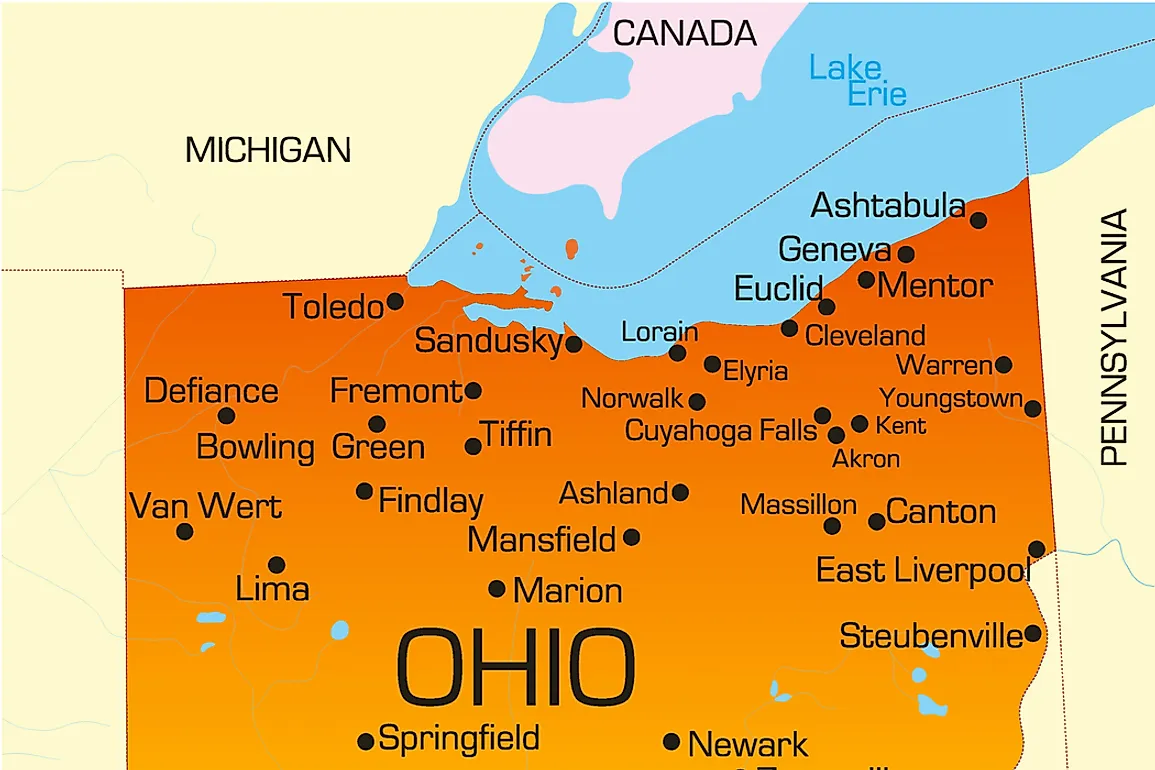What was the Toledo War?

The Toledo War, also referred to as the Michigan-Ohio War, was a boundary dispute between the state of Michigan and Ohio State which lasted from 1835 to 1836. The almost bloodless conflict was caused by the varying interpretation of the law and poor geographical understanding of the great-lakes and which resulted in both states claiming jurisdiction over the 468 square-miles border strip called the Toledo strip.
Background
The Northwest Ordinance was enacted by the Congress of Confederation in 1787 with the primary goal being the creation of the Northwest Territory. The ordinance planned to divide the territory between three to five states in the future. The north-south boundary of three of these states was to be the west and east lines, which are drawn through the southern extreme of the Lake Michigan, which was unknown at that time. During the 1802 Ohio constitutional-convention, the delegates allegedly received a report that the Lake Michigan extended further than was thought previously. As per the trapper, the boundary of Ohio angled slightly towards the northeastern to intersect with Lake Erie at the northerly cape-of Miami Bay referred to as the Harris line.
When Michigan territory was created in 1805, the Congress used the Northwest ordinance which differed from what Ohio’s constitution stipulated. The location of the boundary was contested into the 19th century; in fact, the residence of Port-of-Miami urged Ohio to resolve the problem which they did by when they contacted the Congress about the issue. A survey was done by Edward Tiffin which placed the border of Ohio at the mouth of river Mauwee. In response, Michigan conducted their survey based on the original ordinance line, and they determined that the Ohio boundary was on the southern part of Maumee River. Therefore Ohio refused to surrender and even set up a local government in the Toledo strip.
The Michigan-Ohio Toledo War
The Ohio militia made up of 600 fully armed militiamen was lead by General John Bell arrived in Perrysburg on March 31, 1835. To counter this move, Governor Mason accompanied by General Brown arrived in Toledo with over 1,000 armed militia ready to defend the strip while stopping Governor Lucas from marking the border anymore.
Other than the stabbing of Sheriff Woods by Two Stickney, the conflict had no casualties. The political stalemate stopping Michigan from becoming a state frustrated Governor Mason; therefore he called for the constitutional convention in May 1835. Ohio responded by creating Lucas county after Governor Lucas, and this created even more tension.
Michigan passed the Penalties and Pains Act which made it a criminal offense for anyone living in the Strip to carry out any governmental action from Ohio. Mason appointed Joseph Brown of the 3rd United States Brigade to head a militia to stop the Ohio trespasser, and Lucas responded by sending his militia to the strip. Lucas re-sent his surveyor to mark the Harris line, and General Brown’s militia attacked them. In response governor, Lucas passed numerous controversial acts including establishing Toledo as a Lucas seat. Later Sheriff Wood was stabbed, and under pressure from Ohio the president replaced Governor Mason with Horner.
Outcome
President Jackson signed a bill allowing Michigan to become a state under the condition that they ceded the strip and accepted Upper Peninsula as part of Michigan. Michigan refused the offer but bankruptcy caused by the massive militia funding pushed them to take the offer, and then Michigan became a state which can receive funds from the treasury. The 2nd Ann Arbor delegates’ convention of December 14, 1836 ended the war, and although many deemed it illegal, they accepted the term. Michigan became the 26th state on January 26, 1837. Toledo stripe ended up being a part of Ohio while Michigan extended to Upper Peninsula.
Historical Significance
Toledo war is historically significant because it was the driving force behind the definition of the boundaries of Ohio and Michigan states. The Michigan-Ohio war was an almost bloodless war with no casualties other than the stabbing of Sheriff Wood. The conflict challenged the Northwest ordinance which was enacted by the Congress-of-the-Confederation. To acquire the Toledo strip, the already powerful state of Ohio did everything they could to block Michigan from becoming a state. Although the boundary conflict delayed statehood of Michigan, the territory finally became the 26th state of the United States.











